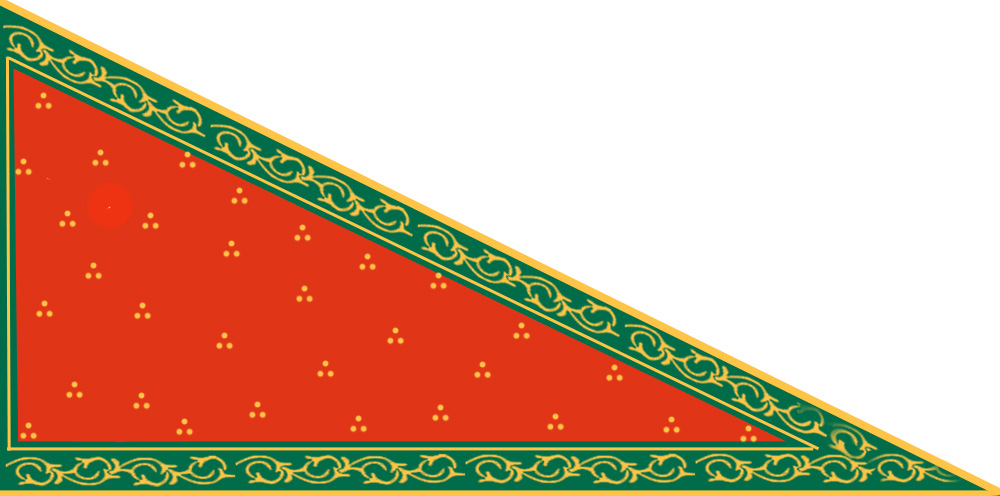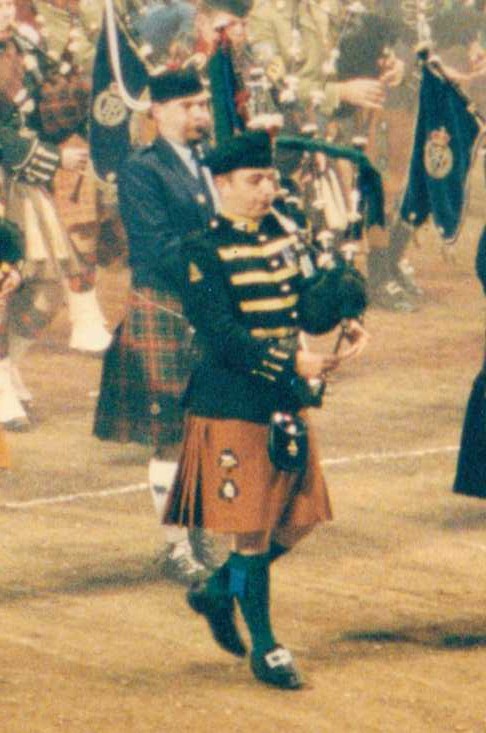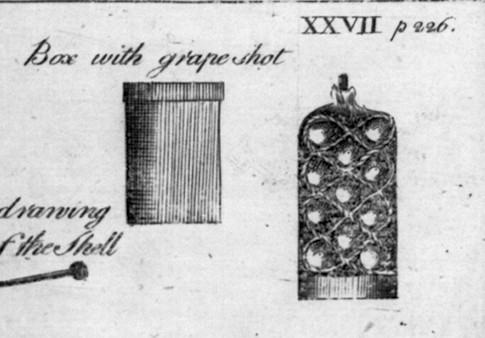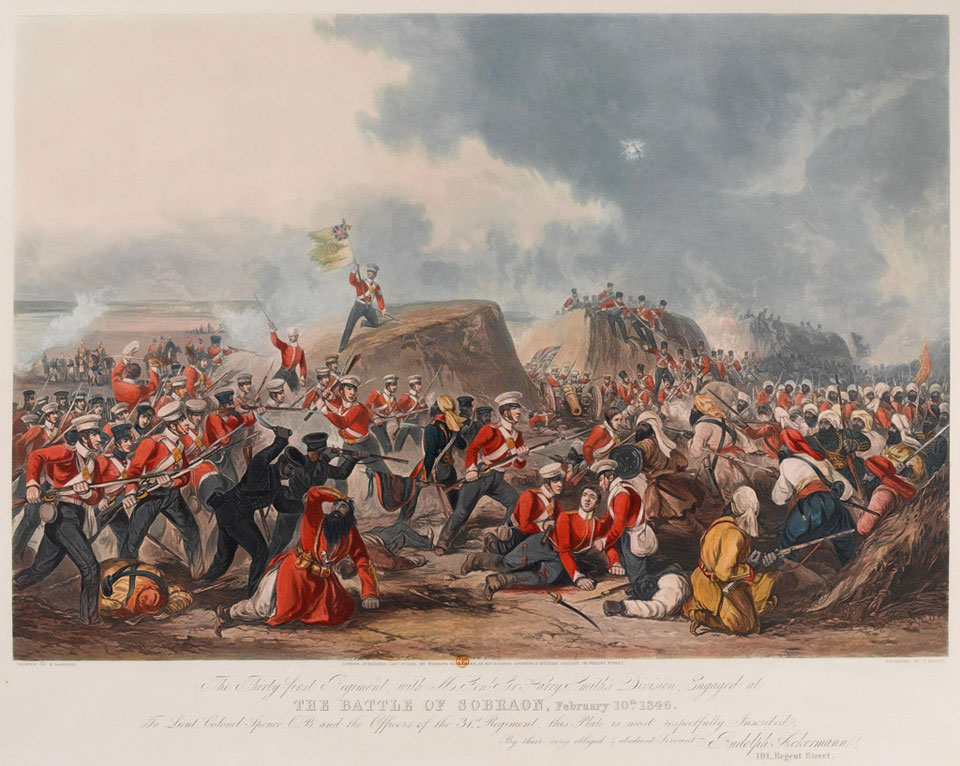|
Battle Of Mudki
The Battle of Mudki was fought on 18 December 1845, between the forces of the East India Company and part of the Sikh Khalsa Army, the army of then declining Sikh Empire of the Punjab. The British army won an untidy encounter battle, sustaining heavy casualties. Background The Sikh Empire of the Punjab had been held together by Maharajah Ranjit Singh. Ranjit Singh had maintained a policy of friendship with the British East India Company, who held territories adjoining the Punjab, while at the same time building up the Khalsa, to deter aggression. When he died in 1839, the Sikh empire fell into increasing disorder. As several successive rulers and ministers were deposed or murdered, the army expanded and became increasingly restive. To secure their hold on power, some of the leaders in the Punjab goaded their army into a war against the British. The Governor General of the Bengal Presidency (and in effect, of all British-controlled India) was Sir Henry Hardinge. Receiving repo ... [...More Info...] [...Related Items...] OR: [Wikipedia] [Google] [Baidu] |
Henry Martens
Henry Martens (1790, London – 1868, London) was an English people, English military illustrator and artist. He worked mainly in water-color although a few oil paintings do exist. He was the eldest of three sons of Christoph Heinrich (''anglice'' Christopher Henry) Martens and his wife Rebecca, the others being John William and Conrad Martens, Conrad. Works Martens exhibited pictures at various galleries including the British Institution and particularly at the Society of British Artists. Between 1828 and 1842, he showed no fewer than 34 water-colors at the latter, the majority depicting military scenes such as ''The Skirmish at Battle of Drumclog, Drumclog'' (1833–34), ''Out-post duty - English Hussars'' (1836), ''Charles I of England, Charles I at the Battle of Naseby'' (1839) and ''Cavalry engagement at Battle of Benavente, Benevente during Sir John Moore (British army officer), John Moore's Retreat'' (1842). He produced work ready for etching from drawings supplied by Cap ... [...More Info...] [...Related Items...] OR: [Wikipedia] [Google] [Baidu] |
Sutlej River
The Sutlej River or the Satluj River is a major river in Asia, flowing through China, India and Pakistan, and is the longest of the five major rivers of the Punjab region. It is also known as ''Satadru''; and is the easternmost tributary of the Indus River. The combination of the Sutlej and Chenab rivers in the plains of Punjab forms the Panjnad, which finally flows into the Indus River at Mithankot. In India, the Bhakra Dam is built around the river Sutlej to provide irrigation and other facilities to the states of Punjab, Rajasthan and Haryana. The waters of the Sutlej are allocated to India under the Indus Waters Treaty between India and Pakistan, and are mostly diverted to irrigation canals in India like the Sirhind Canal, Bhakra Main Line and the Rajasthan canal. The mean annual flow is 14 million acre feet (MAF) (roughly 1.727 × 1013 L) upstream of Ropar barrage, downstream of the Bhakra dam. It has several major hydroelectric points, including the ... [...More Info...] [...Related Items...] OR: [Wikipedia] [Google] [Baidu] |
9th Foot
The Royal Norfolk Regiment was a line infantry regiment of the British Army until 1959. Its predecessor regiment was raised in 1685 as Henry Cornwall's Regiment of Foot. In 1751, it was numbered like most other British Army regiments and named the 9th Regiment of Foot. It was formed as the Norfolk Regiment in 1881 under the Childers Reforms of the British Army as the county regiment of Norfolk by merging the 9th (East Norfolk) Regiment of Foot with the local Militia and Rifle Volunteers battalions. The Norfolk Regiment fought in the First World War on the Western Front and in the Middle East. After the war, the regiment became the Royal Norfolk Regiment on 3 June 1935. The regiment fought with distinction in the Second World War, in action in the Battle of France and Belgium, the Far East, and then in the invasion of, and subsequent operations in, North-west Europe. In 1959, the Royal Norfolk Regiment was amalgamated with the Suffolk Regiment, to become the 1st East Angli ... [...More Info...] [...Related Items...] OR: [Wikipedia] [Google] [Baidu] |
Queen's Royal Hussars
The Queen's Royal Hussars (The Queen's Own and Royal Irish) (QRH) is the most senior armoured regiment in the British Army, equipped with Challenger 2 main battle tanks. The regiment was formed on 1 September 1993 from the amalgamation of the Queen's Own Hussars and the Queen's Royal Irish Hussars. The regiment and its antecedents have been awarded 172 Battle Honours and eight Victoria Crosses. The regiment was based in Sennelager, Germany, until 2019 when it was relocated to Tidworth Camp, England. The Queen's Royal Hussars serves as the armoured regiment for the 20th Armoured Brigade Combat Team. History The Queen's Royal Hussars was formed in Fallingbostel on 1 September 1993 from the amalgamation of the Queen's Own Hussars and the Queen's Royal Irish Hussars. Home Headquarters was formed shortly thereafter at Regent's Park Barracks in London where it remains today. After the amalgamation, the regiment became the cavalry of the following areas: Northern Ireland, Warwicksh ... [...More Info...] [...Related Items...] OR: [Wikipedia] [Google] [Baidu] |
Afghan Cavalry During The Battle Of Mudki (December 18th, 1845) Of The First Anglo-Sikh War (1845–46)
Afghan or Afgan may refer to: Related to Afghanistan *Afghans, historically refers to the Pashtun people. It is both an ethnicity and nationality. Ethnicity wise, it refers to the Pashtuns. In modern terms, it means both the citizens of Afghanistan and Afghans, a country in Central Asia (of any ethnicity) **Afghan (ethnonym), the historic term applied strictly to people of the Pashtun ethnicity **Ethnic groups in Afghanistan, people of various ethnicities that are nationally Afghan * Afghan (biscuit) * Afghan (blanket) * Afghan coat * Afghan cuisine * Afghan Hound, a dog breed originating in parts of Afghanistan and the surrounding regions * Afghan rug * Afghanistan - shortened colloquial name in the Russosphere for the country during the Soviet-Afghan war People Given name * Afghan Muhammad (died 1648), Afghan khan in modern-day Russia Surname * Sediq Afghan (born 1958), Afghan philosopher * Asghar Afghan (born 1987), former Afghan cricketer * Azad Khan Afghan (died 1781), ... [...More Info...] [...Related Items...] OR: [Wikipedia] [Google] [Baidu] |
George Broadfoot
Major George Broadfoot CB (21 March 1807 – 21 December 1845) was a Scottish army officer in the Madras Army of the East India Company. Biography Early life Broadfoot was born in Kirkwall, Orkney, the eldest surviving son of Reverend William Broadfoot.Ardent Media, Dictionary of Indian Biography, p.53 At the age of ten he moved with his family to London where he was educated. In 1825 he obtained a cadetship in the East India Company and on his arrival in India in January 1826 he was posted to the 34th Regiment of Madras Native Infantry as an Ensign. During this period he became good friends with Colin Mackenzie, who sailed on the same ship to India.William Broadfoot, The Career of Major George Broadfoot, C. B. ...: In Afghanistan and the Punjab Paperback – Ulan Press (31 August 2012), ASIN: B009J1HQP8 After seven years service in Madras, Broadfoot returned to England where he would remain for the following five years. Whilst back in Europe he travelled in France, Germany and It ... [...More Info...] [...Related Items...] OR: [Wikipedia] [Google] [Baidu] |
Robert Henry Sale
Major-General Sir Robert Henry Sale (19 September 1782 – 21 December 1845) was a British Army officer who commanded the garrison of Jalalabad during the First Afghan War and was killed in action during the First Anglo-Sikh War. Biography He entered the 36th Regiment of Foot in 1795, and went to India in 1798, as a lieutenant of the 12th Foot. His regiment formed part of Baird's brigade of Harris's army operating against Tippoo Sahib, and Sale was present at Malavalli and the Battle of Seringapatam, subsequently serving under Colonel Arthur Wellesley in the campaign against Dhundia. A little later the 12th was employed in the difficult and laborious attack on Paichi Raja. Promoted captain in 1806, Sale was engaged in 1808–1809 against the Raja of Travancore, and was at the two actions of Quilon, the storm of Travancore lines and the battle of Killianore. In 1810 he accompanied the expedition to Mauritius, and in 1813 obtained his majority. After some years he bec ... [...More Info...] [...Related Items...] OR: [Wikipedia] [Google] [Baidu] |
Grapeshot
In artillery, a grapeshot is a type of ammunition that consists of a collection of smaller-caliber round shots packed tightly in a canvas bag and separated from the gunpowder charge by a metal wadding, rather than being a single solid projectile. When assembled, the shot resembled a cluster of grapes, hence the name. Grapeshot was used both on land and at sea. On firing, the canvas wrapping disintegrates and the contained balls scatter out from the muzzle, giving a ballistic effect similar to a giant shotgun. Grapeshot was devastatingly effective against massed infantry at short range and was also used at medium range. Solid shot was used at longer range and canister at shorter. When used in naval warfare, grapeshot served a dual purpose. First, it continued its role as an anti-personnel projectile. However, the effect was diminished due to a large portion of the crew being below decks and the addition of hammock netting in iron brackets intended to slow or stop smaller shot. ... [...More Info...] [...Related Items...] OR: [Wikipedia] [Google] [Baidu] |
Fauj-i-Ain
The Fauj-i-Ain (Punjabi: ਫੌਜ -ਏ-ਐਨ, Persian: فوج عین) was a branch of the Sikh Khalsa Army and was the regular army of Maharaja Ranjit Singh of Punjab. It contained infantry, cavalry and artillery units. The Fauj-i-Ain had two divisions, the Kampu-i-mu'alla (State Troops), and the Fauj-i-Khas (Special Force). Background Before the reign of Maharaja Ranjit Singh the armies in Punjab, were purely cavalry. After Ranjit Singh became the Sardar of the Sukerchakia Misl, he unified the Misls through diplomacy, strategic marital alliances and conquest. Punjab under Maharaja Ranjit Singh stretched from Kashmir to the Khyber Pass. The Afghans posed a threat to the western frontier of his kingdom, the East India Company to the eastern frontier and the Gurkhas to the northeast. In 1805, he started recruiting deserters from the East India Company as officers or soldiers and commenced training a section of his army in military drill. Trained cannoneers from Pierre Cuilli ... [...More Info...] [...Related Items...] OR: [Wikipedia] [Google] [Baidu] |
King's Own Dragoons At Mudki
Kings or King's may refer to: *Kings: The sovereign heads of states and/or nations. *One of several works known as the "Book of Kings": **The Books of Kings part of the Bible, divided into two parts **The ''Shahnameh'', an 11th-century epic Persian poem **The Morgan Bible, a French medieval picture Bible **The Pararaton, a 16th-century Javanese history of southeast Asia *The plural of any king Business * Kings Family Restaurants, a chain of restaurants in Pennsylvania and Ohio * Kings Food Markets, a chain supermarket in northern New Jersey * King's Favourites, a brand of cigarettes *King's Variety Store, a chain of stores in the USA *King's (defunct discount store), a defunct chain of discount stores in the USA Education * King's College (other), various colleges * King's School (other), various schools * The King's Academy (other), various academies Electoral districts *King's (New Brunswick federal electoral district) (1867–1903) * Kings (Nova ... [...More Info...] [...Related Items...] OR: [Wikipedia] [Google] [Baidu] |
Vizier
A vizier (; ; ) is a high-ranking political advisor or Minister (government), minister in the Near East. The Abbasids, Abbasid caliphs gave the title ''wazir'' to a minister formerly called ''katib'' (secretary), who was at first merely a helper but afterwards became the representative and successor of the ''dapir'' (official scribe or secretary) of the Sasanian Empire, Sassanian kings. In modern usage, the term has been used for government Minister (government), ministers in much of the Middle East and beyond. Several alternative spellings are used in English, such as ''vizir'', ''wazir'', and ''vezir''. Etymology Vizier may be derived from the Arabic ''wazara'' (), from the Semitic root ''W-Z-R''. The word is mentioned in the Quran, where Aaron is described as the ''wazir'' (helper) of Moses, as well as the word ''wizr'' (burden) which is also derived from the same root. It was later adopted as a title, in the form of ''wazīr āl Muḥammad'' () by the proto-Shi'a leaders ... [...More Info...] [...Related Items...] OR: [Wikipedia] [Google] [Baidu] |
Garrison
A garrison is any body of troops stationed in a particular location, originally to guard it. The term now often applies to certain facilities that constitute a military base or fortified military headquarters. A garrison is usually in a city, town, fort, castle, ship, or similar site. "Garrison town" is a common expression for any town that has a military base nearby. The term garrison comes from the French language, French ''garnison'', itself from the verb ''garnir'', "to equip". "Garrison towns" () were used during the Early Muslim conquests, Arab Islamic conquests of Middle Eastern lands by Arabs, Arab-Muslim armies to increase their dominance over indigenous populations. In order to occupy non-Arab, non-Islamic areas, nomadic Arab tribesmen were taken from the desert by the ruling Arab elite, conscripted into Islamic armies, and settled into garrison towns as well as given a share in the Jizya, spoils of war. The primary utility of the Arab-Islamic garrisons was to cont ... [...More Info...] [...Related Items...] OR: [Wikipedia] [Google] [Baidu] |






